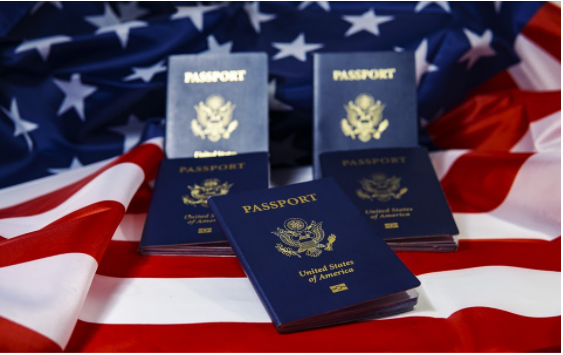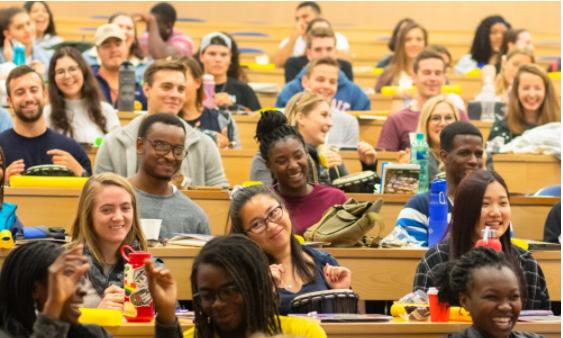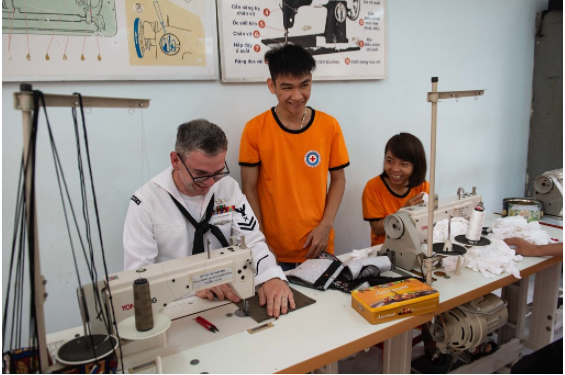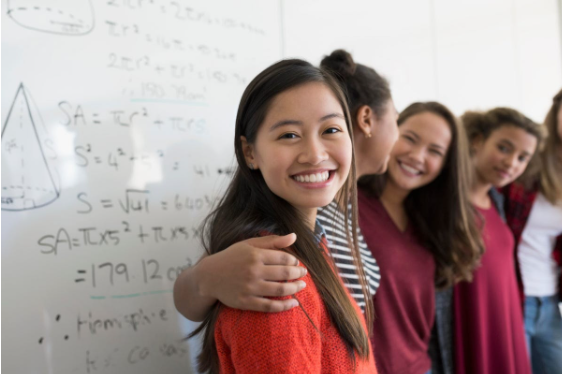
- International students in the USA come to the country mostly on three types of visas:
- F1 student visa,
- M1 vocational or technical training visa, and
- J1 exchange visitor visa.
All about F1 Student Visa

An F1 student visa is designed for students who want to study in the USA full time. The F1 non-immigrant visa allows international students to enter America to pursue academic or professional studies. Pupils are allowed to get an F1 visa once they have been admitted by an approved school, college, or university. To be eligible for an F1 visa, a student should meet the following criteria:
- He/ She must have been accepted by an approved school, college, or university in the USA.
- The student must be enrolled in a full course of study and attend classes at that institution.
- The school or college has to provide documentation confirming that the student has met all admission requirements, is enrolled for full-time study, and has sufficient funds to pay all tuition fees as well as living expenses.
- The student must have a valid passport from their country of citizenship.
F1 Visa Eligibility Criteria
An F1 visa can be granted to international students, who are proficient in the English language, have good academic records, and have sufficient funds for their stay in the USA.
How to apply for an F1 visa?
International students will have to follow certain steps to apply for an F1 student visa:
- Step 1: Firstly, the student should find an accredited school, college, or university in America that accepts international students. Students must be accepted by the school before applying for an F1 visa.
- Step 2: The next step is to apply for the F1 non-immigrant visa at a US embassy or consulate in his/her country of origin or legal residence. The student will have to schedule an appointment for a visa interview and provide the required documents during the visa application. Documents such as acceptance letter, financial documentation, passport with at least six months validity after your intended date of entry in the USA, etc. are some compulsory requirements that must be submitted.
- Step 3: The final step is to pay the visa fees. Every student has to pay a non-refundable $160 application fee, unless exempt.
The visa processing time for an F1 visa is generally 4-6 weeks. During the interview, the consular officer will ask questions about your school and course of study as well as your financial background.
What you can do and not do if you hold an F1 visa?
- An F1 visa allows international students to stay in the USA for as long as their school/college remains approved, or until they complete their course of study. The student can also work on-campus during his/her studies, but may not change into a different non-immigrant status or enter America without permission from USCIS.
- It is important to remember that an F1 visa only allows the holder to study in America. The visa will be canceled if the student does not enroll in school, or begins attending a different institution without permission from USCIS (the United States Citizenship and Immigration Services). If this happens, the student may have to leave the country immediately.
F Visa Types
There are different types of F visas available for students depending on their circumstances:
- F-1 visas for full-time students: Academic students are granted F-1 visas to pursue their studies in America. They may take any number of courses during the day or night but must be enrolled in a full-time course load. High school students can also get an F1 student visa to enter America and pursue their studies. In this case, they will need to provide evidence from their high school that they have been admitted into a full-time course of study and are pursuing it successfully.
- F-2 visas for dependents of F-1 visa holders: Dependents of F-1 visa holders, such as the spouse and children, are allowed to stay in America along with them. However, the only way they can legally reside in the USA is if they have an F-2 visa stamp at their port of entry. It is important to remember that dependents are not allowed to work while holding an F-2 visa.
- F-3 visas for ‘border commuters’: Mexican and Canadian students who reside in their home countries but study in the US part- or full-time need to apply for an F3 visa. The F-3 visa is granted for one year and can be renewed. However, once the student completes his/her degree program in America (or fails to show up at school for more than three months), he/she must return to his/her home country immediately.
TutorHelp.Club experts can help you with everything related to studying in America for international students. We have a team of qualified and experienced professionals who will guide you with their years of experience, knowledge about the universities, course details, admission process, and much more. Submit your query now!
All about M1 Vocational or Technical Training Visa

The M1 visa allows international students to enter the USA for training in a vocational school or non-academic institution that provides training for specific occupations. The M1 visa is designed for students who want to pursue practical training at institutions other than colleges or universities which offer degree programs. To be eligible for an M1 visa, a student should meet the following criteria:
- He/ She must have been accepted by a school, college, or university that offers training for a specific occupation.
- The student must be enrolled in a full-time training program at the institution.
- The school or college has to provide documentation confirming that the student has met all admission requirements, is enrolled for full-time study, and has sufficient funds to pay tuition fees as well as living expenses.
- The student must have a valid passport from their country of citizenship.
M1 Visa Eligibility Criteria
To be eligible for an M1 visa, an international student should hold a valid passport from the country of his/her citizenship and meet certain minimum educational requirements. If you plan on entering the USA to receive training in a specific industry or occupation such as Law Enforcement, Emergency Medical Technician (EMT), etc. then you can apply for an M1 visa.
There are specific requirements that an international student should meet when applying for an M1 visa. These requirements must be met at the time of submission of application and on the day of entry into the USA. Failure to meet these criteria may result in refusal of visa stamping by US consulates or embassies, resulting in a denial of entry into the USA.
Criteria to be eligible for the M1 visa category include:
- The student must have been accepted by a US institution that provides training in a specific occupation or industry. The institution should provide documentation confirming that the student has met all admission requirements, is enrolled for full-time study, and has sufficient funds to pay tuition fees as well as living expenses. The student must have a valid passport from his/her country of citizenship.
- The international student must be enrolled in a full-time training program at the institution that provides instruction for the specific industry or occupation that he/she wishes to pursue after completing M1 visa training.
- The student must have sufficient funds to pay tuition fees as well as living expenses. The required amount of money may vary from school to school and can be found on the website or prospectus of the institution that you have been accepted into.
- A student applying for an M1 visa should not be married and must not have any children who will depend on them for financial support. M1 Visa is issued specifically for Vocational or Technical training and hence a student should not have dependent family members.
How to apply for an M1 visa?
To apply for an M1 visa, international students should follow these steps:
- Step 1: The first step in the application procedure is to file an online non-immigrant visa application (Form DS-160). The student should submit this form along with payment of US$ 160 fee, within 5 days of receiving a Letter of Acceptance from the school. After filing the application, one needs to schedule an appointment at a local US embassy or consulate for an interview and stamping of the visa.
- Step 2: The second step in the application procedure is to appear for an appointment at a local US embassy or consulate to complete the registration process. In this process, students must produce original documentation confirming their admission into a school that provides training for a specific industry/occupation along with other details such as course duration.
- Step 3: After successful completion of the registration process, the student is issued an M1 visa with a validity period of 5 years or until the date on which he/she completes the training program at that US school, whichever comes later.
The entire application procedure including form filing, appointment scheduling, and submission of required documents may take up to 45 days to complete.
What you can do and not do if you hold an M1 visa?
A student holding an M1 visa is allowed to live in the USA with his/her spouse and children. They can also pursue full-time studies at their chosen school. However, during training, students are not allowed to change or adjust their visa status if they wish to take up employment or study elsewhere in the USA.
International students who are in the US with any other visa type cannot change their status to an M1 visa. If they wish to pursue vocational training, they are required to make a fresh visa application for M1.
International students must understand the terms of their training program before applying for an M1 visa. The school should clearly state the duration of the training course, the number of hours to be spent in class and lab per day, as well as the specific days on which classes will be held during the week. This information should be made available on the website or prospectus of the institution that you have been accepted into.
M1 visa holders, who wish to pursue Vocational training, are not allowed to accept employment in the USA. They can work only on campus during their stay in the USA.
All about J1 Exchange Visitor Visa

The J1 visa is designed for students who are coming to the USA on an exchange program for a specific period. In addition, students can receive practical training through their programs to enhance their knowledge and skills that will help them find better jobs when they return home. Participants of J1 visas are allowed to stay in the USA maximum of 18 months while they attend academic courses or complete training. To be eligible for a J1 visa, a student should meet the following criteria:
- He/ She must have been accepted by an authorized exchange visitor program sponsor in the USA.
- The student must be enrolled with an accredited academic institution in the US.
- The education or training has to provide documentation confirming that the student has met all admission requirements and is enrolled in a full-time training program.
- The student must have a valid passport from their country of citizenship.
J1 Visa Eligibility Criteria
To be eligible for a J1 visa, a student should meet the following criteria:
- He/ She must have been accepted by an authorized Student Exchange Visitor Program (SEVP) sponsor in the USA.
- The student must be enrolled with an accredited academic institution in the US. The education institution may issue Form I-20 or DS-2019 for J1 visa students.
- The education or training has to provide documentation confirming that the student has met all admission requirements and is enrolled in a full-time training program.
- The student must have a valid passport from their country of citizenship.
Students who are applying for a J1 visa are required to get a security clearance certificate, fingerprint check, medical examination report, affidavit of support form, Passport copies of dependents and sponsor, copies of passports and visas of all family members who wish to accompany them during their stay in the USA.
How to apply for a J1 visa?
Applicants should apply for a J1 visa following these steps:
- Step 1: You need to apply at the US Embassy/Consulate in their home country.
- Step 2: The embassy will process your visa application and inform you if the consular officer requires any other documents or scheduling an interview.
- Step 3: You need to apply for a visa at least three months before you travel to the USA.
- Step 4: After the interview, an approval or refusal letter will be sent to you. If your visa is approved, then you should bring your passport to the embassy/consulate for collecting your visa.
- Step 5: Make sure that you arrive in the USA before your J1 program starts since you cannot enter the USA after the official end date of your program.
The cost of a J1 visa is $140. Its processing time is of four to five days.
The above J1 visa guidelines provide valuable information about the process and necessary documents that an international student has to submit before applying for a J1 program. The law regarding immigration in the USA is complex; therefore, one should make sure that all requirements are met before applying for this visa category.
What you can do and not do if you hold a J1 visa?
J1 visa students can:
- Attend an academic course in the US.
- Find a part-time job on campus and off-campus, during summer and school breaks after registering with the program sponsor (sponsors may not allow students to work during their official program). They can work a maximum of 20 hours per week when they are in school.
- Participate in practical training for 12 weeks after the completion of their academic studies. It is applicable only to students who have majored in science or engineering.
J1 visa students cannot:
- Attend vocational courses.
- Work on a full-time basis while they are studying unless it is allowed by their programs.
- Study at non-academic institutions such as language schools.
- Stay in the USA after the end date of the program unless they get a job offer or change their status. If you cannot get a job before your J1 program ends, then you should apply for another visa category to stay in the USA until you find a suitable job.
- Stay in the US for more than one academic year unless they have applied to change their status.
- Study without US immigration permission.
The above guidelines provide valuable information about the rights and restrictions that J1 visa students have during their stay in the USA. The rights of J1 students are limited; therefore, they must understand all limitations and apply for a job as soon as possible.
J1 visa students who need to travel during their stay in the US should keep the following things in mind:
- You can enter and leave the USA without any special permission as long as your program end date has not expired.
- Students should carry all important documents such as passports, visas, and other identification proofs when they plan to travel outside the US.
- You should carry a copy of your I-94 card when you return from international travel. The I-94 card will allow administrators to determine if your program end date has been extended.
- If you need to stay in the USA after the end date of your program, then you should apply for a new visa category.
The above guidelines provide valuable information about traveling abroad during J1 visa status. Students must carry all important documents and copies of their I-94 cards before they leave.
TutorHelp.Club has some of the best experts to help international students interested in studying at US universities. It is always advisable to get help from experts when applying for F1, M1, or J1 visas.



0 responses on "Guidelines to Get F1, M1, and J1 Visas in the USA"